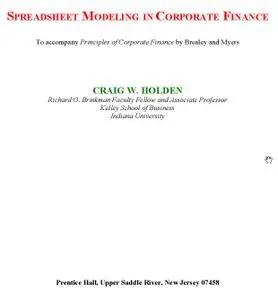Craig W. Holden «Spreadsheet Modeling In Corporate Finance - To accompany Principles of Corporate Finance by Brealey and Myers»
McGraw-Hill | PDF 168 Pages | 1.34 MB
McGraw-Hill | PDF 168 Pages | 1.34 MB
Book Info:
For nearly 20 years, since the emergence of PCs, Lotus 1-2-3, and Microsoft Excel in the 1980’s, spreadsheet models have been the dominant vehicles for finance professionals in the business world to implement their financial knowledge. Yet even today, most Corporate Finance textbooks rely on calculators as the primary tool and have little (if any) coverage of how to build spreadsheet models. This book fills that gap. It teaches students how to build financial models in Excel. It provides step-by-step instructions so that students can build models themselves (active learning), rather than handing students canned “templates” (passive learning). It progresses from simple examples to practical, real-world applications. It spans nearly all quantitative models in corporate finance. .
Why This Book Was Written (author):
My goal is simply to change finance education from being calculator based to being spreadsheet modeling based. This change will better prepare students for the 21st century business world. This change will increase student satisfaction in the classroom by allowing more practical, real-world applications and by enabling a more hands-on, active learning approach.
There are many features which distinguish this book from anything else on the market:
Teach By Example. I believe that the best way to learn spreadsheet modeling is by working through examples and completing a lot of problems. This book fully develops this hands-on, active learning approach. Active learning is a well-established way to increase student learning and student satisfaction with the course / instructor. When students build financial models themselves, they really “get it.” As I tell my students, “If you build it, you will learn.”
Supplement For All Popular Corporate Finance Textbooks. This book is a supplement to be combined with a primary textbook. This means that you can keep using whatever textbook you like best. You don’t have to switch. It also means that you can take an incremental approach to incorporating spreadsheet modeling. You can start modestly and build up from there. Alternative notation versions are available that match the notation of all popular corporate finance textbooks.
Plain Vanilla Excel. Other books on the market emphasize teaching students programming using Visual Basic for Applications (VBA) or using macros. By contrast, this book does everything in plain vanilla Excel. Although programming is liked by a minority of students, it is seriously disliked by the majority. Plain vanilla Excel has the advantage of being a very intuitive, user-friendly environment that is accessible to all. It is fully capable of handling a wide range of applications, including quite sophisticated ones. Further, your students already know the basics of Excel and nothing more is assumed. Students are assumed to be able to enter formulas in a cell and to copy formulas from one cell to another. All other features of Excel (graphing, built-in functions, Solver, etc.) are explained as they are used.
Build From Simple Examples To Practical, Real-World Applications. The general approach is to start with a simple example and build up to a practical, real-world application. In many chapters, the previous spreadsheet model is carried forward to the next more complex model. For example, the chapter on binomial option pricing carries forward spreadsheet models as follows: (a.) single-period model with replicating portfolio, (b.) eight-period model with replicating portfolio, (c.) eight-period model with risk-neutral probabilities, (d.) full-scale, fifty-period model with volatilities estimated from real returns data. Whenever possible, this book builds up to full-scale, practical applications
About the Author:
Craig Holden is the Richard G. Brinkman Faculty Fellow and Associate Professor of Finance at the Kelley School of Business at Indiana University. His M.B.A. and Ph.D. are from the Anderson School at UCLA. He is the winner of multiple schoolwide teaching awards and multiple schoolwide research awards. He has written a book/CD series on Spreadsheet Modeling in finance, which is published by Prentice Hall. His research on security trading and market making (“market microstructure”) has been published in leading academic journals. He has chaired nine dissertations, served on the program committee of the Western Finance Association for three years, and served as an associate editor of the Journal of Financial Markets for four years. He has chaired a department committee for eight years and chaired various schoolwide committees for seven years. He has lead several major curriculum innovations in the finance department. For more details, Craig’s home page is at www.kelley.iu.edu/cholden.



